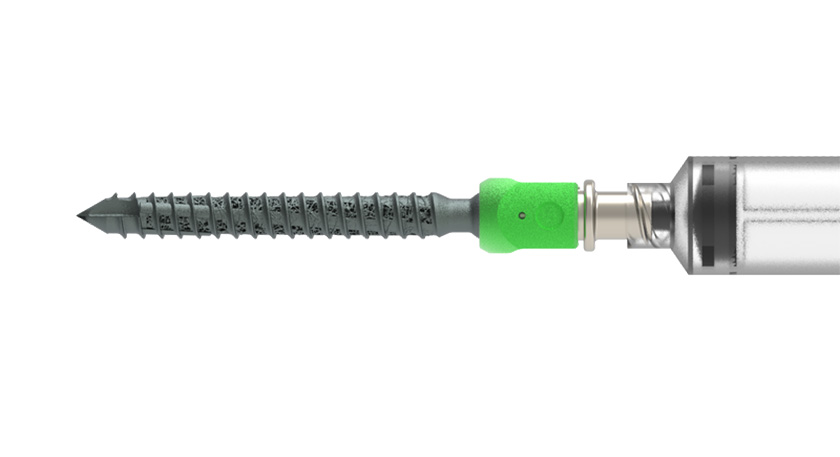
Surgeons, company executives and industry influencers will gather in Denver this month for the 40th NASS Annual Meeting. Members of the BONEZONE team will be there to check in on the latest technologies that promise to improve patient care and learn more about the major players and up-and-coming companies that will define the spine market in the coming years. Here are several we’ll have our eye on in the Mile High City.
Trend Setters
Medtronic, spine’s top player, earned $2.4 billion in 2024 and reported sales of $886 million in the fiscal first quarter of 2026, up 5.1% from the same period in 2025.
The company’s AiBLE digital ecosystem continues to provide a blueprint for market success. AiBLE’s comprehensive offerings allow hospital systems to upgrade with connected navigation, robotics, data capture, AI capabilities and imaging solutions, creating a competitive advantage for Medtronic and leading to consistent growth of enabling technology sales.
Globus Medical’s successful integration of NuVasive has allowed the company to compete with Medtronic at the top of the segment. The company is also adjusting to new leadership after CEO Keith Pfeil was promoted to run the company in July following the resignation of Daniel Scavilla.
Medtronic and Globus Medical are the only two spine companies with double-digit market share. Combined, they account for 42% of global spine sales.
Sales of Globus Medical’s enabling technology sputtered to start the year, but the company’s leadership believes the quality of its offerings provides the advantage it needs to outperform the competition. The company projects 2025 earnings of about $2.9 billion, partially buoyed by its acquisition of Nevro, a device company that focuses on treatments for chronic pain.
In July, the company launched DuraPro, an advanced oscillating system that allows for fast and accurate bone cutting without wrapping tissue and powered soft tissue removal during discectomies. DuraPro integrates with Globus Medical’s ExcelsiusGPS robotic navigation platform and the ExcelsiusHub navigation system.
New Arrivals
VB Spine, the newly-formed privately owned company run by the Viscogliosi brothers, acquired Stryker’s $700 million spine implant business earlier this year in a move that redefined the top of the market. VB Spine execs, far from fresh faces in the industry, plan to use their connections and deep distribution network to expand the company’s implant business with surgeon-focused solutions.
VB Spine’s implants will be exclusively available for implantation with Stryker’s Mako Spine robot and it will be interesting to see if separating the implant and enabling technology businesses will prove as successful as the fully integrated model used predominantly throughout the industry.
Demetra, a company known for developing bone cements, spacers and biomaterials, has been active on the M&A market. In February, the company acquired a majority stake in GetSet Surgical, a Swiss-based maker of sterile-packed spine procedure kits. Demetra also added Bespoke Technologies, which produces sterile-packed 3D-printed titanium implants for ACDF procedures.
Demetra then acquired OrthoFundamentals in September to add a portfolio of implants and sterile-packed instrument kits for SI joint fusion procedures. The deal led to the launch of Demetra Spine, a new business unit that will be exhibiting at NASS. Demetra Spine aims to address instrumentation reprocessing pain points for surgical facilities, particularly in ASC settings.
High-tech Entries
Ruthless Spine recently received FDA 510(k) clearance for NavJam Jamshidi, a wireless, disposable and tablet-based device. NavJam works in concert with Ruthless Spine’s RJB intraoperative angle measurement instrument to provide surgeons with real-time and data-driven guidance trajectory feedback during the placement of lumbosacral pedicle screws.
Digital ecosystems have emerged as a key component of competing in the spine market, so it will be interesting to see this streamlined platform that offers an alternative to larger scale and more expensive navigation systems.
LEM Surgical received FDA clearance for its Dynamis Robotic Surgical System, an integrated navigation-based platform that features three robotic arms — two dedicated to surgical guidance and one for optical navigation — on a single cart that fits partially beneath the operating table. The system, which combines real-time imaging, dynamic guidance and adaptable instrumentation compatibility, is designed to bring greater accuracy and control to spine surgery while improving surgical efficiencies and workflows.
The Dynamis system will be introduced in select U.S. hospitals later this year, with broader commercialization planned for 2026.
Spine’s top implant companies and numerous new technology entrants boast robotic platforms, and we’re curious to see the latest addition to the mix.
Fast Risers
ATEC is among the market’s steadiest risers and has positioned itself as one of the larger pure-play spine company in the industry. The company is on a clear growth trajectory and raised its full-year 2025 guidance to $742 million in total revenue, representing 21.3% growth over 2024.
ATEC’s planned launch of the Valence navigated robotic system by the end of the year will pair the technology with the company’s already installed EOS imaging systems to create a compact and user-friendly platform that provides a solid base for future growth. ATEC’s annual revenue is projected to exceed $1 billion by 2027 and push the company into spine’s top tier of earners.
Highridge Medical is privately held and run by industry veterans who are operating it as “spine’s largest startup.”
In June, the company sold EBI, its Bone Healing division, to Avista Healthcare Partners as part of a larger strategy to focus on core spine solutions. Three months later, Highridge Medical acquired the FlareHawk and Toro expandable interbody fusion systems and the LineSider pedicle screw system from Accelus. The deal also added Accelus’ Adaptive Geometry implant designs to expand Highridge Medical’s offerings in the expandable interbody implant market and adds to its technology-driven portfolio.
Orthofix has been on a steady growth trajectory over the past three years and generated $286 million in spine sales in 2024. The company’s portfolio includes spinal implants, orthobiologics and the 7D Flash Navigation system, which helps surgeons perform accurate and efficient minimally invasive spine fusions procedures. In the first half of 2025, U.S. placements of the 7D System increased 66% compared to the same period a year ago.
Orthofix is integrating advanced optics and AI-driven planning into the 7D System to move closer to fully personalized, real-time spine alignment verification. The company is focused on delivering faster, safer and more cost-effective procedures.
SI-Bone’s revenues have also been on a steady climb in recent years to reach $167 million in 2024. The company’s iFuse implant is a minimally invasive option for treating sacroiliac joint disorders, a niche market that’s primed for significant growth. SI-BONE, which has more than doubled its surgeon user base since 2022, is positioned to capitalize on the opportunity.
Please reach out if you know of a company or technology you’d like us to check out, or if you’d like to meet with a member of our team at NASS.
DC
Dan Cook is a Senior Editor at ORTHOWORLD. He develops content focused on important industry trends, top thought leaders and innovative technologies.




